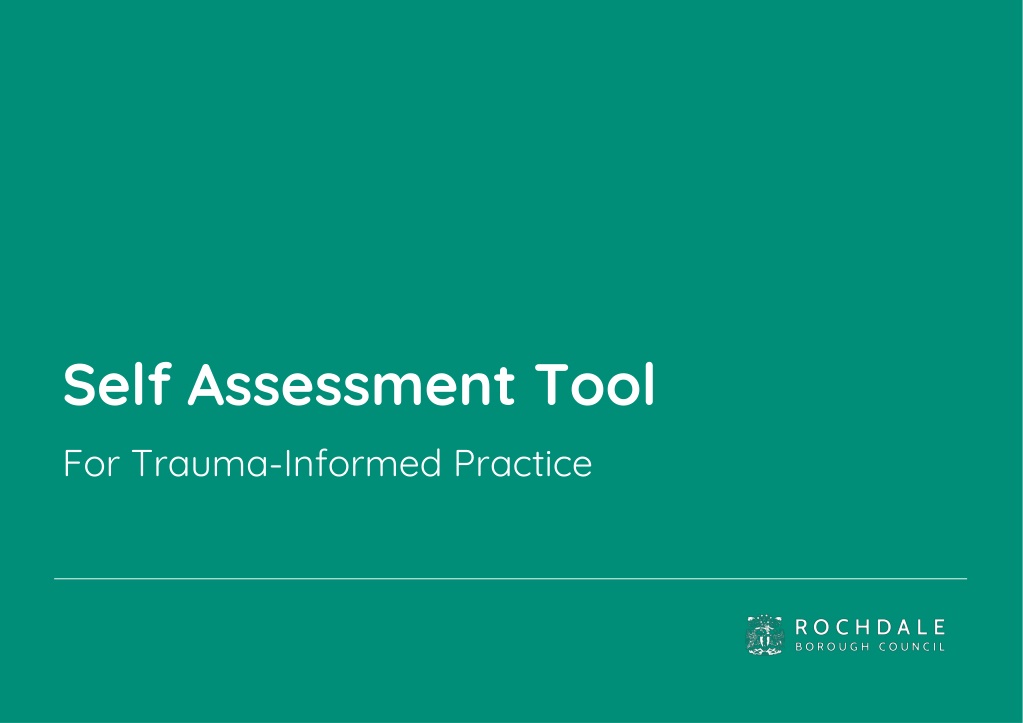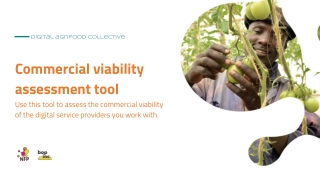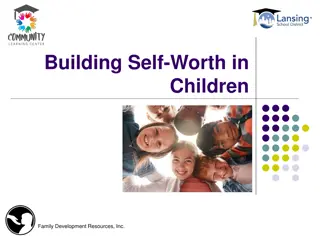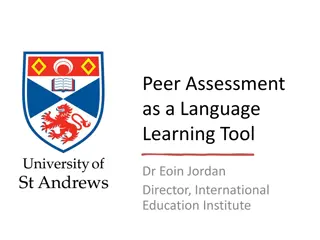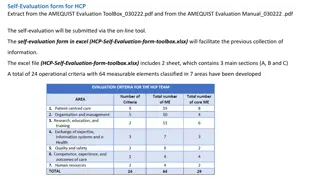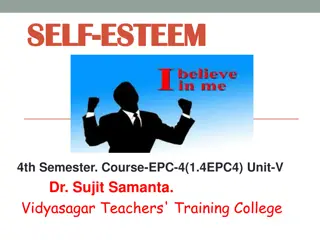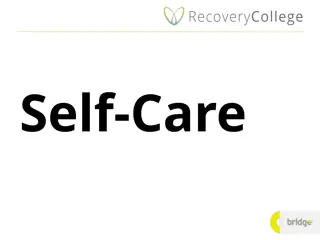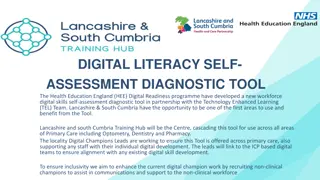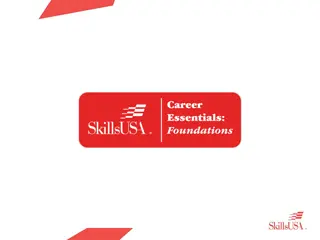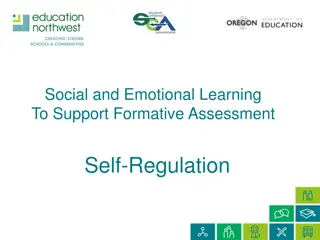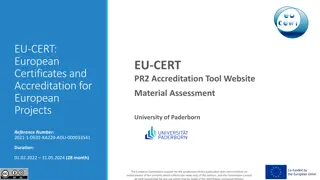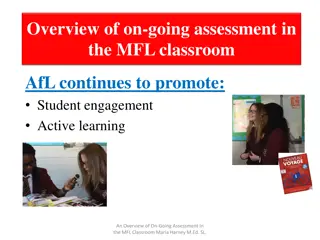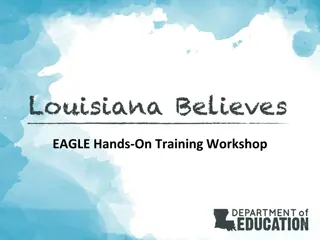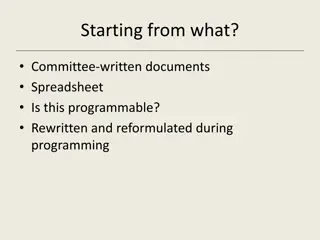Self Assessment Tool
This self-assessment tool is designed to support organizations in Rochdale to enhance trauma-informed practice. It focuses on screening, supportive relationships, strengths-based support, collaboration, safe environments, training, secondary trauma, leadership, and ethos. The tool aims to help teams evaluate their current level of trauma-informed practice, identify areas for improvement, and facilitate positive changes.
Download Presentation

Please find below an Image/Link to download the presentation.
The content on the website is provided AS IS for your information and personal use only. It may not be sold, licensed, or shared on other websites without obtaining consent from the author.If you encounter any issues during the download, it is possible that the publisher has removed the file from their server.
You are allowed to download the files provided on this website for personal or commercial use, subject to the condition that they are used lawfully. All files are the property of their respective owners.
The content on the website is provided AS IS for your information and personal use only. It may not be sold, licensed, or shared on other websites without obtaining consent from the author.
E N D
Presentation Transcript
Self Assessment Tool For Trauma-Informed Practice
Contents How to use this tool 3 Screening, identifying and recording trauma and ACEs 4 Supportive Relationships 5 Strengths-based support 6 Collaboration 7 Safe Environments 8 Training 9 Secondary Trauma 10 Leadership and ethos 11
How to use this tool What it is How to use it The self-assessment tool is designed to support the work of children s, adult s and families services in Rochdale. It is based on 8 features of trauma-informed practice, based on the Early Intervention Foundation s framework for trauma- informed care and adapted by leading practitioners across Rochdale. The features include: This tool is aimed to support organisations and services to build on their existing strengths and opportunities. It aims to help teams understand the level of development of trauma-informed practice in their service, to define potential areas for development and help embed change. Developing new ways of working is not easy and this tool is not designed as an appraisal but as a helpful guide to accompany teams and leaders on their journey to working in a more trauma-informed way. Screening and identifying and recording trauma and ACEs Supportive Relationships It is best used in collaboration with wider members of the service team. For example, it can support the running of: Strengths-based support Reflective practice sessions Safe Environments Supervision spaces Training Leadership meetings Secondary Trauma You will find a list of service departments in column 3 who can support you and your team on your journey to further embed trauma-informed practice. Collaboration Leadership & Ethos Indicators for good practice across these features are based on children, families and practitioners testimonials. 3
TRAUMA-INFORMED PRACTICE FEATURES Screening, identifying and recording trauma and ACEs INDICATORS OF GOOD PRACTICE WHO CAN SUPPORT ON THE JOURNEY DEFINING EMBEDDING THRIVING & LEADING Children and families understand what will happen with any information they share NEST Areas for TIP development & a joint vision are being defined Improved ways of working are being embedded Vision for TIP and outcomes are actively owned by all members of the team. Great practice is shared with the wider system. Complex Safeguarding Practitioners recognise the signs of trauma & understand how trauma can make it more difficult to engage Youth Justice Further Education CYP and families only need to tell their story once. Public Health Assessment and referral forms capture information relevant to trauma, including identity, lived experience and harm Specialist Nurses Safeguarding RCT Assessments truly capture the child s journey and the impact chronology Practitioners are confident in asking about traumatic events in a compassionate and sensitive way with both children and parents Children and young people feel believed when they tell their story Practitioners are equipped to offer trauma- informed care or refer to more specialist services Information about their trauma and history informs the support they receive in the setting. Case audits review how trauma is recorded and used to inform planning Children and young people connected to potentially traumatic incidents are asked about the impact on them (e.g. violent incident) Children and young people are not asked to tell their story multiple times and relive traumatic experiences and details. 4
TRAUMA-INFORMED PRACTICE FEATURES Supportive Relationships INDICATORS OF GOOD PRACTICE WHO CAN SUPPORT ON THE JOURNEY DEFINING EMBEDDING THRIVING & LEADING Children and families have a single worker who knows them well and has time to spend with them and advocates for them with other agencies NEST Areas for TIP development & a joint vision are being defined Improved ways of working are being embedded Vision for TIP and outcomes are actively owned by all members of the team. Great practice is shared with the wider system. Early Help Early Years Children and young people feel that they have good relationships with a range of practitioners who support them across different agencies Complex Safeguarding RCT Voluntary sector resources and expertise are used to build relationships with children and families alongside professional services Matthew Moss H. School Family members are supported to develop social networks in the community Practitioners can access advice from expert relational practitioners Supervision reflects the importance of the relationship between the practitioner and the child or family - practitioners are invited to reflect on what they might do to improve the relationship with the young person, rather than being directed in particular ways. Quality assurance activity explores the social and emotional way of working with children and young people, identifying good relational practice There are opportunities for children, young people and families to form relationships that do not end when support end (e.g. with a universal service provider) CYPF feel seen and believed by the people who support them 5
TRAUMA-INFORMED PRACTICE FEATURES Strengths-based support INDICATORS OF GOOD PRACTICE WHO CAN SUPPORT ON THE JOURNEY DEFINING EMBEDDING THRIVING & LEADING Assessments start with the positive about the young person NEST Areas for TIP development & a joint vision are being defined Improved ways of working are being embedded Vision for TIP and outcomes are actively owned by all members of the team. Great practice is shared with the wider system. Early Help Families are empowered through the ability to choose their own worker, where and when to meet, and the outcomes they want to achieve. Early Years Complex Safeguarding Practitioners focus on what went right for the child or young person, and celebrate their progress Youth Justice Specialist Schools When things go wrong, practitioners focus on understanding what happened and what the child, young person or parent was communicating with their behaviour CAMHS RCT Children and young people are offered support to develop life skills to help them with communication, relationships and social situations Matthew Moss H. School People supporting children and young people focus on solutions, rather than problems and provide them with helpful strategies for their lives. Children and young people are actively encouraged and supported to participate in decisions about their future. Responses to incidents are driven by a trauma- informed understanding (e.g. arrests for domestic abuse) rather than performance targets. 6
TRAUMA-INFORMED PRACTICE FEATURES Collaboration INDICATORS OF GOOD PRACTICE WHO CAN SUPPORT ON THE JOURNEY DEFINING EMBEDDING THRIVING & LEADING Services comes together around the child or young person, in a place where they feel safe (e.g. school) Early Years Areas for TIP development & a joint vision are being defined Improved ways of working are being embedded Vision for TIP and outcomes are actively owned by all members of the team. Great practice is shared with the wider system. Early Help Practitioners know what services and resources are available locally and how to draw on them to support children young people and families ACT - Achieving Change Together No Wrong Door Practitioners can access expert advice and support in identifying and responding to trauma when they need it Designated School Liaison Project Specialist Schools Multi-disciplinary teams share a common language for talking about children and young people and understanding the role of trauma in their lives CAMHS RCT Adult Social Care Service managers and leaders look for opportunities to collaborate with other services, including by pooling funding and co-locating staff to better meet the needs of children and families The service champions trauma-informed practice with its partners, offers challenge to improve and shares opportunities to learn about trauma informed practice together Children, young people and families are involved in designing new multi-disciplinary approaches or arrangements, so they are informed by lived experience. Children and young people get specialist support when needed because keyworkers are able to support them to access it. 7
TRAUMA-INFORMED PRACTICE FEATURES Safe environments INDICATORS OF GOOD PRACTICE WHO CAN SUPPORT ON THE JOURNEY DEFINING EMBEDDING THRIVING & LEADING Contact with children and families is trauma- informed from the moment they enter the building - they are welcomed and referred to by name as soon as possible. NEST Areas for TIP development & a joint vision are being defined Improved ways of working are being embedded Vision for TIP and outcomes are actively owned by all members of the team. Great practice is shared with the wider system. Early Help Early Years Children young people and families have the opportunity to choose where and when they meet with practitioners Youth Justice RCT Appointments aren t always necessary to get advice and support. There are ways for CYP to informally access support. There are regular audits of the safety and welcoming environment in the main site for the service Children and young people are asked for their views on what would make spaces safer and more welcoming Where practitioners meet families in the home, practitioners consider if this is a safe environment and who else might be present. People supporting children and young people consider whether home is a safe environment for them, and how the impact of an unsafe home can be reduced. When children and young people do not attend an appointment, practitioners seek to find out why, and how they can be supported to attend 8
TRAUMA-INFORMED PRACTICE FEATURES Training INDICATORS OF GOOD PRACTICE WHO CAN SUPPORT ON THE JOURNEY DEFINING EMBEDDING THRIVING & LEADING Training in trauma reaches everyone in the organisation or service, from leaders to temporary staff so that everyone understands the impact of and responses to trauma. Early Help Areas for TIP development & a joint vision are being defined Improved ways of working are being embedded Vision for TIP and outcomes are actively owned by all members of the team. Great practice is shared with the wider system. Complex Safeguarding Youth Justice Children, young people and families are involved in developing and delivering training so that it includes an element of lived experience. Probation Educational Psychology Training offers opportunities to reflect and discuss the impact of trauma and how to respond to it. Workforce Development Hopwood Hall Practitioners have opportunities to reflect on their own cases and are supported to identify trauma, and missed opportunities to reduce the impact Public Health GM Integrated Care System Practitioners have opportunities to reflect on a wider set of cases through multi-disciplinary conversations and participating in case audits. Specialist Nurses Safeguarding RCT Training is delivered by trauma-informed champions who can offer expertise and experience in practice and is informed by research evidence Adult Social Care Frontline practitioners have the confidence and skills to facilitate trauma-informed work, including group work, anti-discriminatory practice and responding to challenging behaviour Training sessions have embedded follow up support and opportunities for discussion or reflection. Training gives practitioners the language to talk about trauma and trauma -informed practice. 9
TRAUMA-INFORMED PRACTICE FEATURES Secondary Trauma INDICATORS OF GOOD PRACTICE WHO CAN SUPPORT ON THE JOURNEY DEFINING EMBEDDING THRIVING & LEADING Practitioners have the opportunity to talk about their relationships with children young people and families and the impact this has on the practitioner as part of supervision arrangements NEST Areas for TIP development & a joint vision are being defined Improved ways of working are being embedded Vision for TIP and outcomes are actively owned by all members of the team. Great practice is shared with the wider system. Early Help Early Years Practitioners have access to clinical advice and support, or emotional coaching to manage the emotional impact of the work. Complex Safeguarding Practice Improvement Understanding staff s lived experience and how it affects their work (positively and negatively) is part of the ethos of the organisation Educational Psychology Public Health There is a process for additional support at points of crisis, e.g. a homicide or serious violence incident to help practitioners manage their emotional responses CAMHS RCT Expectations on staff are realistic and they are never left alone to cope Police 10
TRAUMA-INFORMED PRACTICE FEATURES Leadership and ethos INDICATORS OF GOOD PRACTICE WHO CAN SUPPORT ON THE JOURNEY DEFINING EMBEDDING THRIVING & LEADING Trauma and the need for trauma-informed practice is included in the organisation s mission and vision for children and families RCT Areas for TIP development & a joint vision are being defined Improved ways of working are being embedded Vision for TIP and outcomes are actively owned by all members of the team. Great practice is shared with the wider system. Public Health Policies and procedures refer to trauma explicitly and provide guidance on offering a trauma- informed response Hopwood Hall Complex Safeguarding Leaders understand and talk about the impact of trauma on children and families and champion trauma-informed ways of working. NEST Early Help Leaders commit resources to supporting trauma-informed practice, including the staff time to use this support Quality assurance and audit activity consider trauma and the 8 features of effective trauma- informed practice HR and occupational health recognise the impact of secondary trauma and have processes in place to reduce the impact. Trauma-informed principles inform commissioning strategies and practice, considering the potential for re-traumatisation in auxiliary services (e.g. hospital transport, placements) 11
